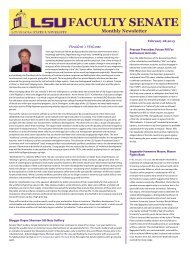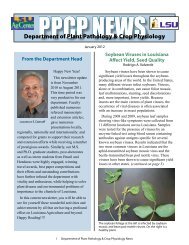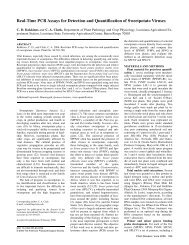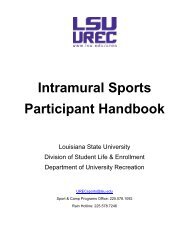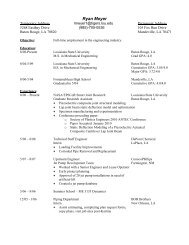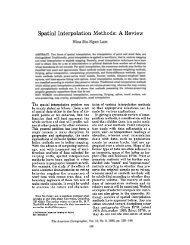FACULTY SENATE - Louisiana State University
FACULTY SENATE - Louisiana State University
FACULTY SENATE - Louisiana State University
You also want an ePaper? Increase the reach of your titles
YUMPU automatically turns print PDFs into web optimized ePapers that Google loves.
Raises - or Raised Eyebrows?<br />
If there were ever an incentive to calisthenics, it must surely be the raises recently announced by the LSU System, which<br />
alternately set faculty leaping up and raising their arms in exclamatory joy but also throwing themselves on the floor in<br />
astounded disappointment. When LSU officialdom announced raises, it proclaimed a four percent increment for most<br />
employees, but, to date, the only recipients of the full increment seem to be those in the LSU System office, those in<br />
administrative positions, or those in the enviable position of leveraging a counter-offer or equity claim. In more than one<br />
college, Deans deployed home-brewed social justice programs in which raises to senior faculty members were clipped<br />
in order to buoy up those with less experience and shorter histories of service, thus sending the message that loyalty<br />
and accomplishment yield taxation and penalties rather than reward and thus bringing age discrimination back into the<br />
headlines. Further up the river, at the other LSU System campuses, the alleged four percent “raise” devolved into a onetime<br />
supplement, the future of which remained murky. All the way up at the top of the state, LSUS employees learned<br />
that they might receive two percent increments beginning in January, if at all. Meanwhile, civil service employees who<br />
achieved satisfactory job performance ratings were granted a straight-up four percent raise, thus signaling that <strong>Louisiana</strong><br />
universities value six months of office work above a lifetime of research. Also swirling through but hard to see within<br />
this mix is the one-half percent that the state retirement agency clipped from the “normal cost” that reaches employee<br />
retirement accounts, a reduction that not only trimmed a tidy sum from the “raise” but that left employees of other<br />
university systems, where no raises were bestowed, poorer than ever. Assuming that the LSU employees who received<br />
a partial raise constitute approximately one-third of the <strong>Louisiana</strong> higher education work force and taking all of the<br />
aforementioned reductions into account, the total increase for all of <strong>Louisiana</strong> higher education falls below one-half of one<br />
percent.<br />
Monument in the Making?<br />
In one of the most bizarre episodes to date in<br />
the history of the “one LSU” consolidation, the<br />
great east wing of LSU’s Thomas Boyd Hall,<br />
once the LSU Chancellor’s office, has been<br />
vacated, padlocked, and otherwise immured<br />
in mothballs. Window treatments have been<br />
drawn; house plants formerly seen in windows<br />
have wilted away; and seekers after the campus<br />
leadership encounter darkened doors and heavy<br />
locks. Optimists speculate that the building,<br />
which resembles the Ark of the Covenant, may<br />
be headed for conversion into a monument<br />
commemorating the days before the outsourcing<br />
of leadership; skeptics opine that the building is<br />
undergoing decontamination.<br />
America’s Hub Airports<br />
Memphis International<br />
Voyagers from <strong>Louisiana</strong> universities routinely fan out across America and the world in their pursuit of new knowledge,<br />
professional connections, and occasional encounters with high life. There was a day when all those traveling to or from<br />
<strong>Louisiana</strong> passed through a handful of hub airports. In recent years, the coming and going of several discount carriers and<br />
the introduction of increasing competition from airports in Lafayette and Lake Charles have made it possible to travel to<br />
one’s final destination through a variety of transfer points. The invention of computer-assisted travel planning through<br />
sites such as kayak.com and hipmunk.com have made it possible to reach any city through a variety of routes. To assist<br />
traveling professionals in attaining the optimal if not always a good travel experience, the Newsletter offers the following<br />
capsule evaluation of a baker’s dozen of hub cities that often enough pop up on itineraries beginning in <strong>Louisiana</strong>.<br />
Ranking is from worst to best, so, to borrow from both aviation and the LSU cheereleaders, “the only way is up”!<br />
Coming in at position number thirteen and decidedly the worst option for <strong>Louisiana</strong> travelers is Memphis International,<br />
which rose to great prominence as a hub for Northwestern but which has slipped since becoming a secondary hub for<br />
Atlanta-based Delta. Looking for all the world like a cold-war backyard bomb shelter, this clumsy and highly amalgamative<br />
brick monstrosity features tornado shelter stations in the men’s toilets and offers some of the most uncomfortable chairs, in<br />
waiting areas, that designers have ever deployed. Most annoying are the endless lowbrow allusions to Elvis Presley, whose<br />
music pervades every corridor, to whom shops are dedicated, and after whom restaurant dishes are named. Despite the<br />
appearance of a multiplicity of restaurants in common areas, most operate out of a common commissary and kitchen, with<br />
the predictable depletion of variety and nutritional potential. MEM does have the advantage of a few nonstop KLM flights<br />
to Amsterdam, making it a quick connection to Europe, but it has not benefitted in any way from the huge influx of cash<br />
brought by its chief tenant, the FedEx cargo operation.<br />
Close behind Memphis—chasing MEM by a tail—is aging Atlanta International Airport, once the glorious symbol of the<br />
economically expansive new south but now the architectural epitome of stagnation and rearward glances. Low ceilings,<br />
long corridors, and deteriorating flooring combine to<br />
inspire gratitude for short connection times. Atlanta<br />
remains inadequately endowed with amenities. Usable<br />
electrical connections are few and far between; waiting<br />
areas are disproportionately narrow. As does Memphis,<br />
Atlanta consolidates its food services in food court areas<br />
in which common facilities increase operating efficiencies,<br />
but the result is some of the lowest-quality food ever to hit<br />
the trash can. As for sanitation—well, Atlanta inspires<br />
continence.<br />
Atlanta International Airport<br />
Hovering in the eleventh place is perdurable New York JFK Airport, from which one can reach almost any major<br />
international city but which is sparsely served by domestic carriers save for connecting flights attendant on international<br />
arrivals and departures. Truth be told, JFK has little to recommend other than its enormous range of international travel<br />
options and its oaring Bauhaus-inspired design, which, admittedly, conveys the sense of former grandeur—with an<br />
emphasis on grandeur. JFK is impaired by the inconvenience of its location—at least forty-five minutes into the city—and<br />
by its surprising lack of amenities, there being only one genuine restaurant (other than snack food stalls) in this otherwise<br />
impressive ampitheater of travel. It is amazing that a venue that processes hundreds of thousands of travels per year could<br />
convey such a sense of sober vacancy. (continued on page 9)<br />
Lockdown at Bill<br />
Jenkins’s Old Office<br />
Remember, Ozzie And Harriet Has<br />
Been Cancelled<br />
Most everyone who monitors university<br />
fundraising regards the “TAF,” the Tiger Athletic<br />
Foundation, as one of the most efficient and<br />
cleanest philanthropic organizations of its<br />
kind. Nevertheless, there is always room for<br />
improvement. Isn’t it about time to rethink events<br />
such as the August 14th bash, “Kathy Miles and<br />
Coaches’ Wives”? If the official line is true—that<br />
college football is all about opportunity—<br />
shouldn’t there are least be a “Coaches’ Husbands”<br />
event?<br />
Investigative Reporter Traces $87K<br />
Southern Handout<br />
Tyler Bridges, the inquisitive report for The<br />
Lens, has discovered $87,000.00 in scholarships<br />
distributed on a purely discretionary basis by<br />
members of the Southern <strong>University</strong> Board of<br />
Supervisors. Those who have heard that Southern<br />
and other schools hunger for tuition will want to<br />
read the damage report .





